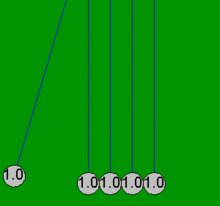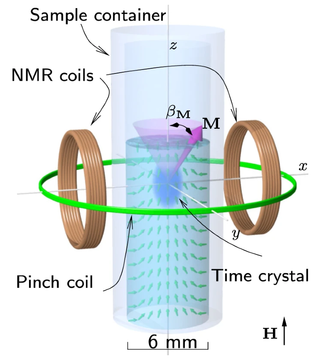Quantum RAM Potentially Unlocked With Time Crystals
Nature and physics are in a perpetual state of discovery.

In 2016, two separate groups of researchers claimed to have created the first time crystals - originally proposed by Nobel Prize-winning physicist Frank Wilczek in 2012. The first of those groups was helmed by Google engineers in collaboration with researchers from Stanford, Princeton and other universities. Their results, published in Nature, claimed to have created the exotic phase of matter within a quantum computer. In a true demonstration of convergence, another, unrelated team of researchers announced the creation of the world's first time crystal inside a diamond that same year. Now, as covered by Interesting Engineering, scientists with the Aalto University in Finland have created a system where two of these time crystals interact - cracking the doors ever so slightly towards a RAM-like equivalent for quantum computing.
In pop culture, Muse's song "The 2nd Law: Isolated System" states that "in an isolated system, entropy can only increase" - a reference to the second law of thermodynamics, which essentially states that all systems tend to disorder over a sufficient enough time. Time crystals apparently strain this concept by enabling the creation of perpetual motion machines - they move in a periodic, repeating cycle, sustaining a predictable and constant pattern of changing states without burning or creating energy. If you've ever seen a Newton Cradle, a popular executive toy, you can see how this works in your mind's eye.

To create their system, the researchers cooled a quantity of helium-3, an isotope of helium that becomes a superfluid when cooled to a fraction above absolute zero (minus 459.67 degrees Fahrenheit, or minus 273 degrees Celsius). Being a superfluid, there's no viscosity, which means no energy is lost to friction, thus allowing time crystal's movement to continue indefinitely.
In the experiment, the "indefinitely" equated to a pretty finite 1,000 seconds (nearly 17 minutes) of coherence. But in quantum, where coherence times typically hover around a few milliseconds (depending on qubit type, hardware configurations, and operational procedures), it's the quantum equivalent of several lifetimes.

Since no energy is spontaneously created, time crystals obey the principle of conservation of energy, and are described as achieving "motion without energy". They still need a driver of sort (a laser or another medium) to sustain their state, or they'd fall towards equilibrium and cease their perpetual motion. But since this happens without energy actually being added to the system in any way - not even as heat - no new physics need apply. And as an added bonus, the new research posits that these interlinked time crystals could eventually be made to operate at room temperature, doing away with expensive and complex cooling systems - such as IBM's Goldeneye - that are a requirement for some types of qubits.
Yet physicists and industry experts are still coming to grips with how exactly this technology will unfold. And yet, the time crystals' long-lived stability is already bringing eyes upon this new phase of matter. Speaking with Quanta Magazine, Roderich Moessner, director of the Max Planck Institute for the Physics of Complex Systems in Dresden, Germany, and a co-author on the original Google paper, credited time crystals' stability as something that's especially unusual in the field of quantum computing - and human ingenuity tends to make useful things out of the unusual.
Florian Preis, physicist and engineer at Quantum Brilliance - known for its room-temperature, diamond-based qubits - said that time crystal's unusually long stability times, along with predictability, could theoretically open up the door to the quantum equivalent of RAM memory. This stability through time is what gives them the sci-fi flair of time crystals.
Stay on the Cutting Edge
Join the experts who read Tom's Hardware for the inside track on enthusiast PC tech news — and have for over 25 years. We'll send breaking news and in-depth reviews of CPUs, GPUs, AI, maker hardware and more straight to your inbox.
These long coherence times stand in contrast with the fundamental element of quantum computing - the qubit - whose fickleness has industry juggernauts and quantum specialists such as IBM, Microsoft, IonQ, and others racing against one another towards quantum supremacy. Risking oversimplification, a number of qubits (quantum transistors) can produce the equivalent complexity of CPU cores - hence the term Quantum Processing Unit (QPU). Perhaps time crystals will eventually unlock quantum computing's analog to system RAM - encoding information that's available for a long enough period of time to be operated on by qubits themselves.
“Everyone knows that perpetual motion machines are impossible,” Samuli Autti, a research fellow and lecturer in physics at Lancaster University in the United Kingdom, said in a statement to Ram Rayong. “However, in quantum physics, perpetual motion is okay as long as we keep our eyes closed,” he finished.
It seems that blinking too is an indispensable part of quantum physics.

Francisco Pires is a freelance news writer for Tom's Hardware with a soft side for quantum computing.
-
Blatantruth If we can make a working quantum buffer capable of holding one half of an entangled pair, we can send messages across light hours and get around the light speed barrier. All you need to do is either leave your local half alone or break the entanglement just before it's twin arrives at the far point. Even if you are stuck with a binary entangled or not entangled for the arriving bit, having instantaneous communication is worth the pain of setting it up. Your quantumly entangled carrier signal still needs to make the journey the long way, but your information can be transmitted in just the last few meters of that journey, giving you one hell of an effective ping.Reply -
drivinfast247 Reply
I was thinking the same thing.Blatantruth said:If we can make a working quantum buffer capable of holding one half of an entangled pair, we can send messages across light hours and get around the light speed barrier. All you need to do is either leave your local half alone or break the entanglement just before it's twin arrives at the far point. Even if you are stuck with a binary entangled or not entangled for the arriving bit, having instantaneous communication is worth the pain of setting it up. Your quantumly entangled carrier signal still needs to make the journey the long way, but your information can be transmitted in just the last few meters of that journey, giving you one hell of an effective ping.
:neutral: -
8924th ReplyBlatantruth said:If we can make a working quantum buffer capable of holding one half of an entangled pair, we can send messages across light hours and get around the light speed barrier. All you need to do is either leave your local half alone or break the entanglement just before it's twin arrives at the far point. Even if you are stuck with a binary entangled or not entangled for the arriving bit, having instantaneous communication is worth the pain of setting it up. Your quantumly entangled carrier signal still needs to make the journey the long way, but your information can be transmitted in just the last few meters of that journey, giving you one hell of an effective ping.
Creating entangled pairs isn't the problem, but rather that there's not much you can do using them because while observing the state of one can guarantee the state of another, it also un-entangles them and they no longer stay in lockstep with each other.
Mass Effect may have made us think that, "hey, why are we not using this technology ourselves, we can literally also entangle pairs!" but the very premise is flawed due to the destructive nature of observation collapsing the wave function and breaking the bond. -
peterf28 This will fill the memory with data from the future. You will have data/solution before you actually run the computation. Crazy.Reply -
Exploding PSU I like how future tech names are sounding more and more like something from Destiny / Halo / Mass Effect / (insert your favourite futuristic Sci-Fi franchise here)Reply -
TJ Hooker Reply
Quantum entanglement/teleportation still doesn't allow for faster-than-light communication. This is a common misconception.Blatantruth said:If we can make a working quantum buffer capable of holding one half of an entangled pair, we can send messages across light hours and get around the light speed barrier. All you need to do is either leave your local half alone or break the entanglement just before it's twin arrives at the far point. Even if you are stuck with a binary entangled or not entangled for the arriving bit, having instantaneous communication is worth the pain of setting it up. Your quantumly entangled carrier signal still needs to make the journey the long way, but your information can be transmitted in just the last few meters of that journey, giving you one hell of an effective ping. -
husker ReplyTJ Hooker said:Quantum entanglement/teleportation still doesn't allow for faster-than-light communication. This is a common misconception.
I have been told this many times by people much smarter than I am. It is a result of the so called Observer Effect in physics - which is sometimes confused with the Uncertainty Principle. I get that... But then how is it that we can have entangled quantum particles as a key component to quantum computers from which we read values? From my limited understanding they are using either entangled particles or quantum teleportation of particles in order the read the resulting values from a quantum "computation". Wouldn't a faster than light communication device using entangled particles be a much simplified (although vastly spread apart) version of a quantum computer with a count of just a couple of "useful" qubit pairs? What am I missing? -
TJ Hooker Reply
I'm far from an expert myself. But from my very limited understanding, the crux of the issue is that you can't force an entangled particle to take a certain value without breaking the entanglement. For a quantum computation, you're simply reading out the results of the computation. But to communicate, you need the ability to dictate the values the qubits take, but that cannot be done without breaking entanglement.husker said:I have been told this many times by people much smarter than I am. It is a result of the so called Observer Effect in physics - which is sometimes confused with the Uncertainty Principle. I get that... But then how is it that we can have entangled quantum particles as a key component to quantum computers from which we read values? From my limited understanding they are using either entangled particles or quantum teleportation of particles in order the read the resulting values from a quantum "computation". Wouldn't a faster than light communication device using entangled particles be a much simplified (although vastly spread apart) version of a quantum computer with a count of just a couple of "useful" qubit pairs? What am I missing? -
husker Reply
Ah, a subtle but important distinction - Thank you!TJ Hooker said:I'm far from an expert myself. But from my very limited understanding, the crux of the issue is that you can't force an entangled particle to take a certain value without breaking the entanglement. For a quantum computation, you're simply reading out the results of the computation. But to communicate, you need the ability to dictate the values the qubits take, but that cannot be done without breaking entanglement.
Most Popular


